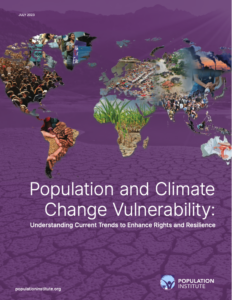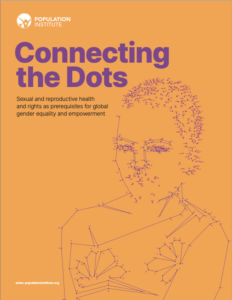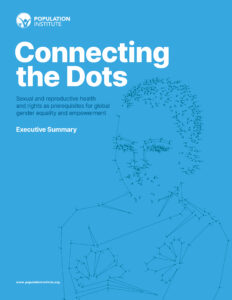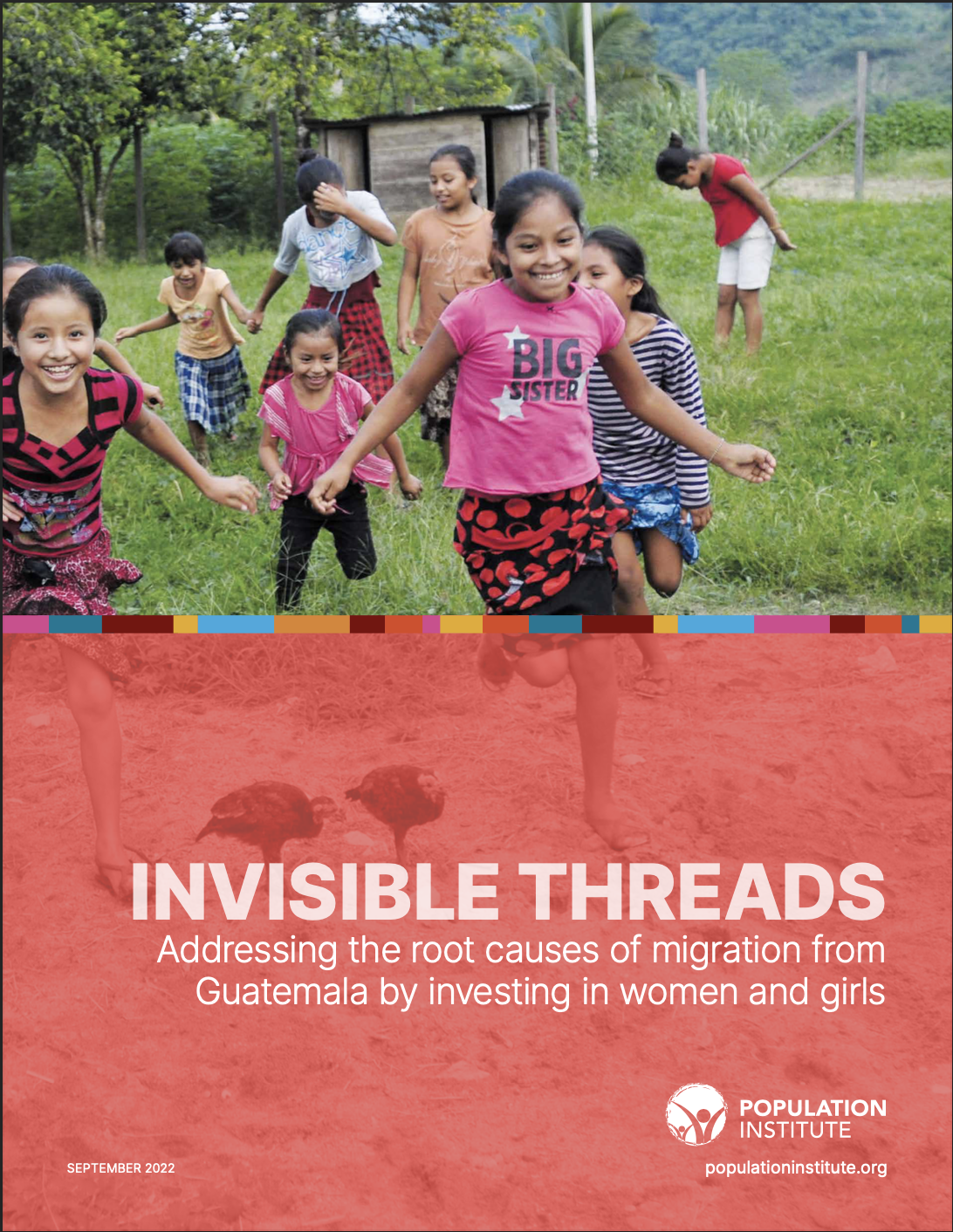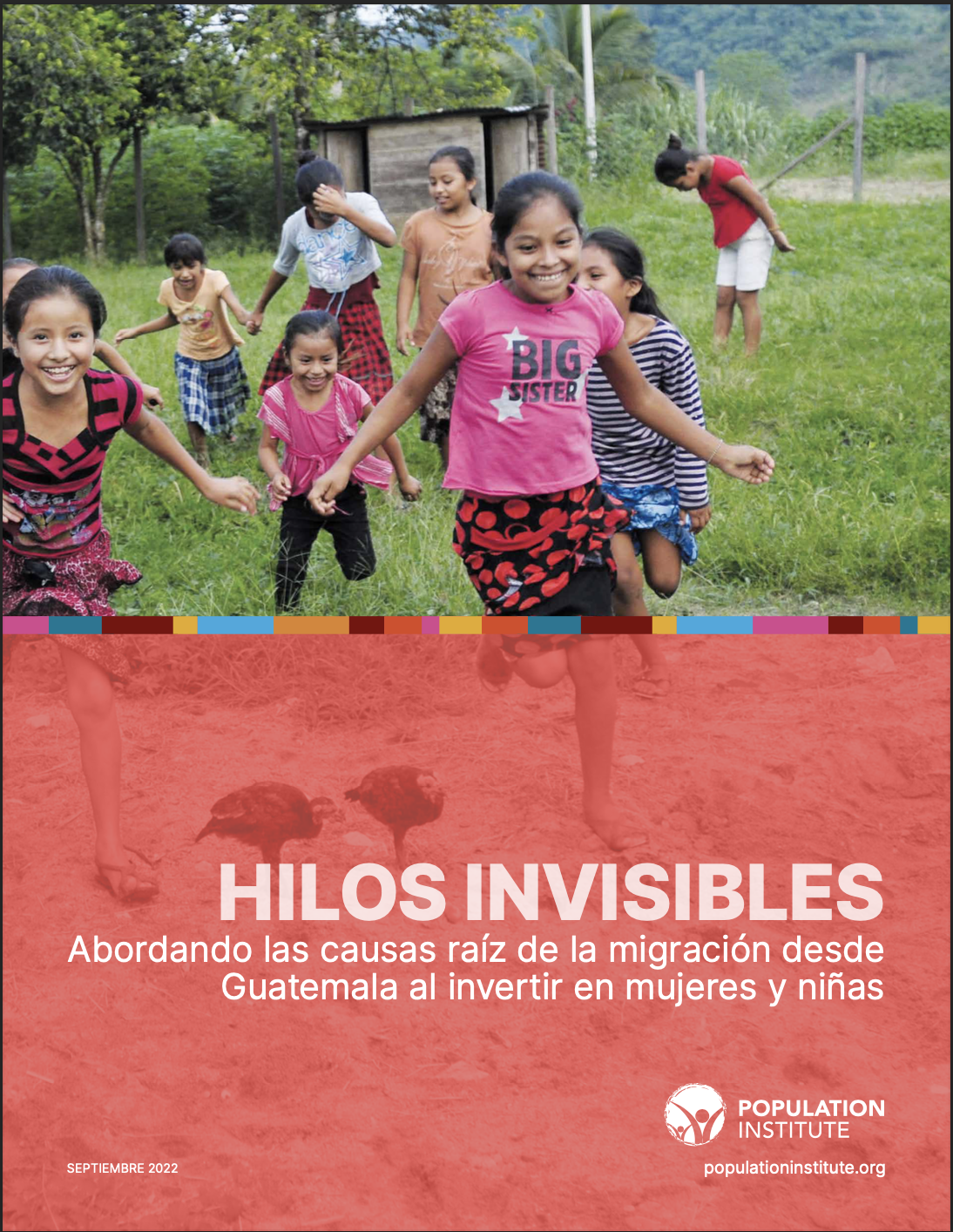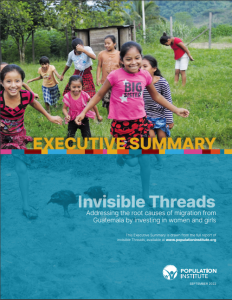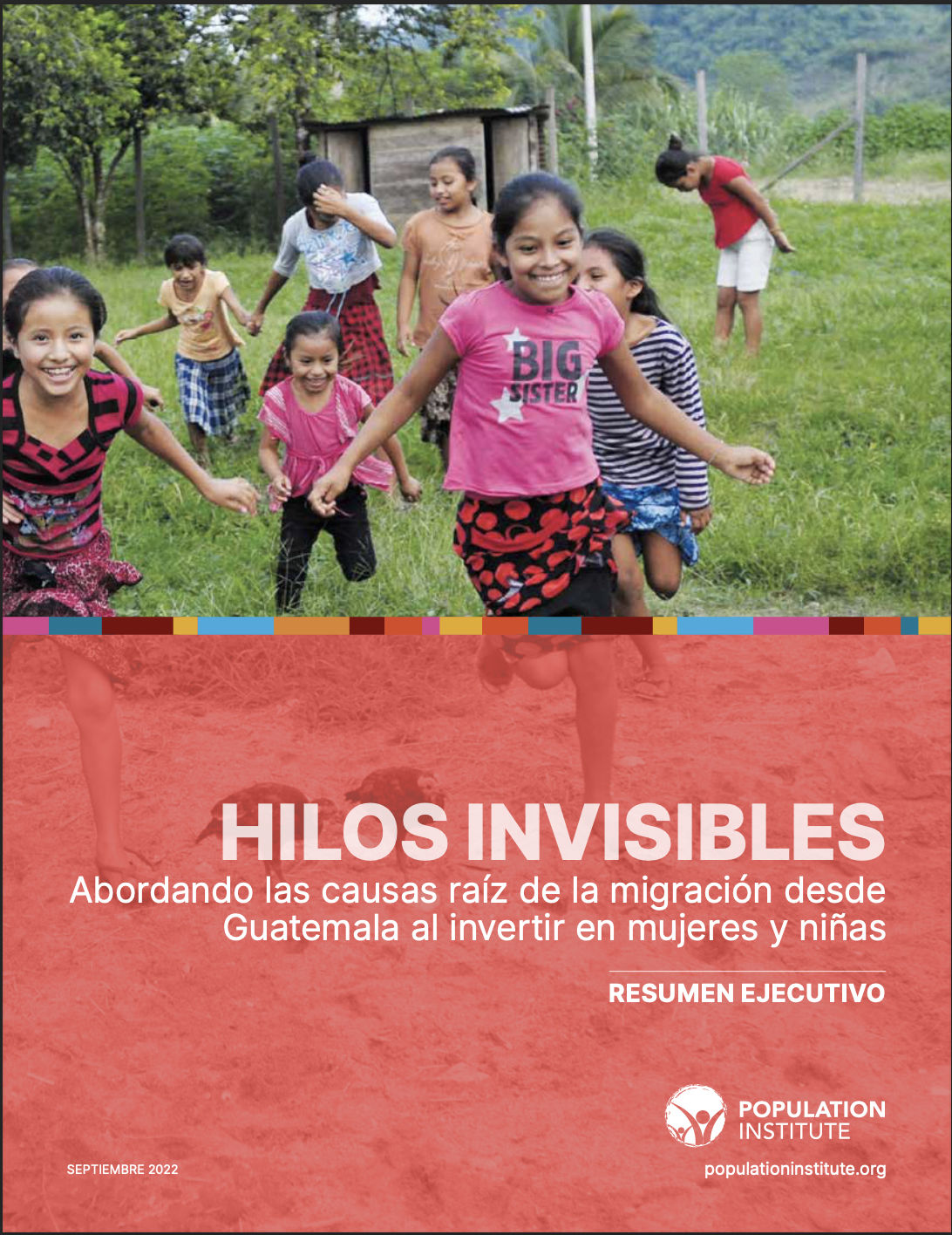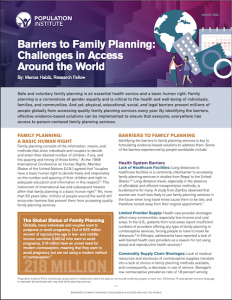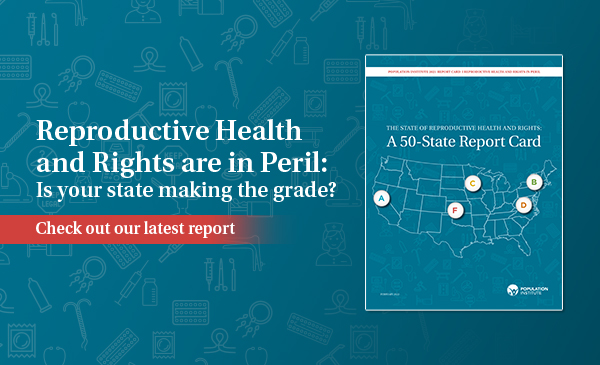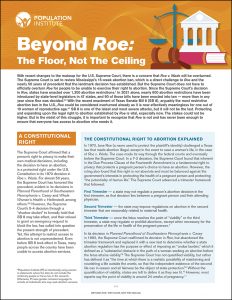Safe and voluntary family planning is an essential health service and a basic human right. Family planning is a cornerstone of gender equality and is critical to the health and well-being of individuals, families, and communities. And yet, physical, educational, social, and legal barriers prevent millions of people globally from accessing quality family planning services every year. By identifying the barriers, effective evidence-based solutions can be implemented to ensure that everyone, everywhere has access to person-centered family planning services.
Explore this page to learn more about some of the barriers that exist around the world that prevent individuals from accessing the family planning services they deserve.
Read our brief report to understand some of the barriers to family planning services that people experience worldwide.
Watch this animation for an overview of why family planning is important and the types of barriers to family planning services experienced by people around the world.
Interact with this map to learn about specific examples of some of the barriers that prevent people from accessing family planning services. Hover over a highlighted country to read about one of the barriers that exists there.
1Guttmacher Institute. (2020, November). Induced Abortion in Indonesia. Guttmacher Institute. https://www.guttmacher.org/fact-sheet/induced-abortion-indonesia
2Bhatt, N., Bhatt, B., Neupane, B., Karki, A., Bhatta, T., Thapa, J., Basnet, L. B., & Budhathoki, S. S. (2021). Perceptions of family planning services and its key barriers among adolescents and young people in Eastern Nepal: A qualitative study. PloS one, 16(5), e0252184. https://doi.org/10.1371/journal.pone.0252184
3Jourdan, D. (2021, December). The journey towards comprehensive sexuality education: Global report. In 4th IAAH MENA Region adolescent health conference: Adolescent care, Leaving no one behind. Paris, France: UNESCO.
4Che, Y., Dusabe-Richards, E., Wu, S., Jiang, Y., Dong, X., Li, J., Zhang, W. H., Temmerman, M., Tolhurst, R., & INPAC group (2017). A qualitative exploration of perceptions and experiences of contraceptive use, abortion and post-abortion family planning services (PAFP) in three provinces in China. BMC women’s health, 17(1), 113. https://doi.org/10.1186/s12905-017-0458-z
5Government of India Ministry of Health and Family Welfare Statistics Division Rural Health Statistics. (2019). https://main.mohfw.gov.in/sites/default/files/Final%20RHS%202018-19_0.pdf
6Mustafa, G., Azmat, S. K., Hameed, W., Ali, S., Ishaque, M., Hussain, W., Ahmed, A., & Munroe, E. (2015). Family Planning Knowledge, Attitudes, and Practices among Married Men and Women in Rural Areas of Pakistan: Findings from a Qualitative Need Assessment Study. International journal of reproductive medicine, 2015, 190520. https://doi.org/10.1155/2015/190520
7DeGraw, E., E. Rottach, and S. Parveen (2019). Male engagement in family planning: Understanding policy implementation barriers and enablers in Bangladesh. Health Policy Plus. http://www.healthpolicyplus.com/pubs.cfm?get=18497
8Alomair, N., Alageel, S., Davies, N., & Bailey, J. V. (2021). Barriers to sexual and reproductive wellbeing among Saudi women: A qualitative study. Sexuality Research and Social Policy. https://doi.org/10.1007/s13178-021-00616-4
9Gueye, A., Speizer, I. S., Corroon, M., & Okigbo, C. C. (2015, December). Belief in Family Planning Myths at the Individual and Community Levels and Modern Contraceptive Use in Urban Africa. International perspectives on sexual and reproductive health. https://www.ncbi.nlm.nih.gov/pmc/articles/PMC4858446/#R
10Habte, A., Dessu, S., Bogale, B., & Lemma, L. (2022). Disparities in sexual and reproductive health services utilization among urban and rural adolescents in southern Ethiopia, 2020: A comparative cross-sectional study. BMC Public Health, 22(1). https://doi.org/10.1186/s12889-022-12634-x
11Solo, J., & Festin, M. (2019). Provider bias in family planning services: a review of its meaning and manifestations. Global Health: Science and Practice, 7(3), 371-385. https://doi.org/10.9745/GHSP-D-19-00130
12Adelekan, A., Omoregie, P., & Edoni, E. (2014). Male involvement in family planning: Challenges and way forward. International Journal of Population Research, 2014, 1–9. https://doi.org/10.1155/2014/416457
13Solo, J., & Festin, M. (2019). Provider bias in family planning services: a review of its meaning and manifestations. Global Health: Science and Practice, 7(3), 371-385. https://doi.org/10.9745/GHSP-D-19-00130
14Daff, B. M., Seck, C., Belkhayat, H., & Sutton, P. (2014). Informed push distribution of contraceptives in Senegal reduces stockouts and improves quality of family planning services. Global Health: Science and Practice, 2(2), 245-252. doi:10.9745/GHSP-D-13-00171
15chrumpf, L. A., Stephens, M. J., Nsarko, N. E., Akosah, E., Baumgartner, J. N., Ohemeng-Dapaah, S., & Watt, M. H. (2020). Side effect concerns and their impact on women’s uptake of modern family planning methods in rural Ghana: a mixed methods study. BMC women’s health, 20(1), 1-8. doi: 10.1186/s12905-020-0885-0
16Silumbwe, A., Nkole, T., Munakampe, M. N., Milford, C., Cordero, J. P., Kriel, Y., ... & Steyn, P. S. (2018). Community and health systems barriers and enablers to family planning and contraceptive services provision and use in Kabwe District, Zambia. BMC health services research, 18(1), 1-11.
17Potasse, M. A., & Yaya, S. (2021, February 2). Understanding perceived access barriers to contraception through an African feminist lens: a qualitative study in Uganda. BMC Public Health.
18Speizer, I. S., Hotchkiss, D. R., Magnani, R. J., Hubbard, B., & Nelson, K. (2000). Do service providers in Tanzania unnecessarily restrict clients' access to contraceptive methods?. International Family Planning Perspectives, 13-42.
19Ministerio de Salud Pública y Asistencia Social - MSPAS/Guatemala, Instituto Nacional de Estadística - INE/Guatemala, Secretaría de Planificación y Programación del la Presidencia - Segeplán/Guatemala, and ICF International. 2017. Encuesta nacional de salud materno infantil 2014-2015: informe final. Rockville, Maryland, USA: MSPAS, INE, Segeplán and ICF International. http://dhsprogram.com/pubs/pdf/FR318/FR318.pdf
20Bahamondes, L., Fernandes, A., & Monteiro, I. (2017). Barriers to implementing and consolidating a family planning program that would meet Brazilian needs. Revista Brasileira de Ginecologia e Obstetrícia, 39, 373-375.
21Irons, R. (2021). Venezuelan women’s perception of sexual and reproductive health services in Lima, Peru. Revista Peruana de Medicina Experimental y Salud Pública, 38, 248-253.
22Ranji, U., Long, M., Salganicoff, A., Silow-Carroll, S., Rosenzweig, C., Rodin, D., & Kellenberg, R. (2019). Beyond the Numbers: Access to reproductive health care for low-income women in five communities. Kaiser Family Foundation. https://www.kff.org/womens-health-policy/report/beyond-the-numbers-access-to-reproductive-health-care-for-low-income-women-in-five-communities/
23Hulme, J., Dunn, S., Guilbert, E., Soon, J., & Norman, W. (2015). Barriers and facilitators to family planning access in Canada. Healthcare policy = Politiques de sante, 10(3), 48–63.
24Dansereau, E., Schaefer, A., Hernández, B., Nelson, J., Palmisano, E., Ríos-Zertuche, D., Woldeab, A., Zúñiga, M. P., Iriarte, E. M., Mokdad, A. H., & El Bcheraoui, C. (2017, October 17). Perceptions of and barriers to family planning services in the poorest regions of Chiapas, Mexico: a qualitative study of men, women, and adolescents. Reproductive health. https://www.ncbi.nlm.nih.gov/pmc/articles/PMC5646150/
25Jourdan, D. (2021, December). The journey towards comprehensive sexuality education: Global report. In 4th IAAH MENA Region adolescent health conference: Adolescent care, Leaving no one behind. Paris, France: UNESCO.
26Gele, A. A., Musse, F. K., Shrestha, M., & Qureshi, S. (2020). Barriers and facilitators to contraceptive use among Somali immigrant women in Oslo: A qualitative study. PloS one, 15(3), e0229916. https://doi.org/10.1371/journal.pone.0229916
27Väisänen, H., Koponen, P., Gissler, M., & Kontula, O. (2018). Contraceptive use among migrant women with a history of induced abortion in Finland. The European Journal of Contraception & Reproductive Health Care, 23(4), 274-281.
